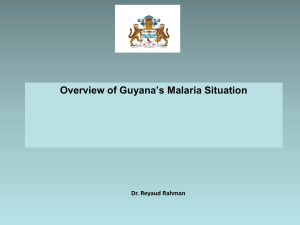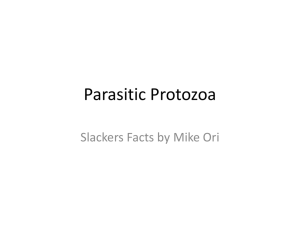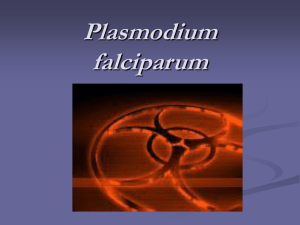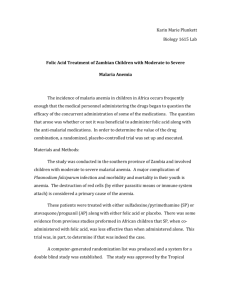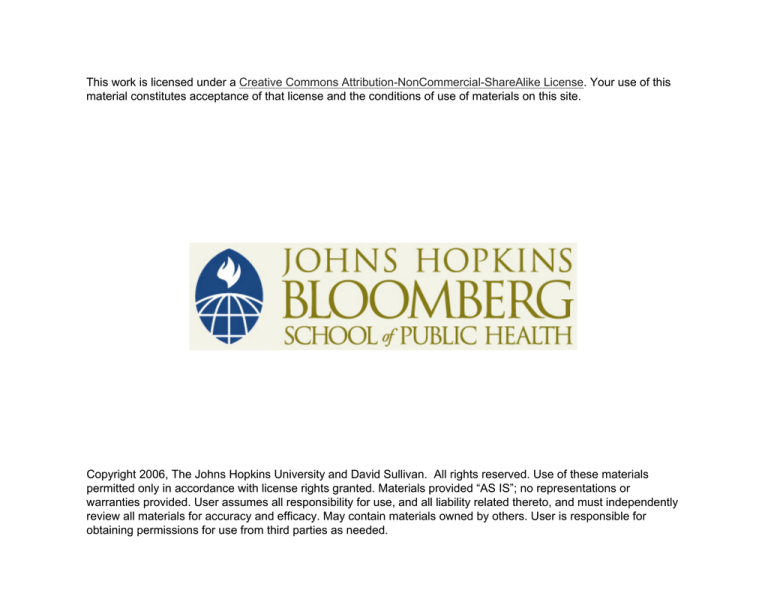
This work is licensed under a Creative Commons Attribution-NonCommercial-ShareAlike License. Your use of this
material constitutes acceptance of that license and the conditions of use of materials on this site.
Copyright 2006, The Johns Hopkins University and David Sullivan. All rights reserved. Use of these materials
permitted only in accordance with license rights granted. Materials provided “AS IS”; no representations or
warranties provided. User assumes all responsibility for use, and all liability related thereto, and must independently
review all materials for accuracy and efficacy. May contain materials owned by others. User is responsible for
obtaining permissions for use from third parties as needed.
Diagnosis and Clinical
Complications
David Sullivan, MD
Classical Malaria
• Fever
• Splenomegaly
• Anemia
Hippocrates, 5th Century BC
106
“Tertian” P. vivax
105
Temperature F
Comparison of Malaria
Fever Curves
104
Adapted from Thayer and Hewetson
Johns Hopkins Hosp Reports V 1895 p. 3-224
103
102
101
100
99
98
97
96
0
24
48
72
96
120
144
Hours
“Quartan” P. malariae
106
“Aestivo-autumnal “Quotidian”
P. falciparum
106
105
105
104
103
Temperature F
Temperature F
104
102
101
100
99
98
102
101
100
99
98
97
96
103
97
0
24
48
72
Hours
96
120
144
96
0
24
48
72
Hours
96
120
144
Diagnosis Based on Clinical
Features
Advantages
Disadvantages
Cheap
Lack of precision
Fast
Over-treatment
CDC/ Dr. Lyle Conrad
Axial temperature is not a
good indicator of malaria
infection in children under
holoendemic conditions, as
often less than 10% of
infections are associated with
fever.
Inaccuracies of Clinical Diagnosis
• Malaria is difficult to diagnose clinically
• In studies > 70% of +ve diagnoses are
non-parasitemic
• Beware statistics based on clinical
reports
Diagnosis Based on Microscopy
Advantages
Disadvantages
Gold standard
Time consuming
Quantitative
Relies upon good
microscopes, reagents,
and trained technicians
Useful for other
diseases
CDC/Dr. Michael Rein
CDC/Dr. Michael Rein
Useful Web Sites for Training in Blood
Film Analysis
This site is presented by the Division of Laboratory
Medicine at Royal Perth Hospital.
http://www.rph.wa.gov.au/malaria.html
• Dr. Richard Davis AM PhD MSc FAACB FIBMS MASM
• Mr. Graham Icke MSc CBiol FIBiol FIBMS Grad Dip Bus
CDC site
http://www.dpd.cdc.gov/dpdx/HTML/Malaria.asp?bo
dy=Frames/M-R/Malaria/body_Malariadiagfind2.htm
Fig. 1: Normal red cell
Figs. 2-18: Trophozoites (among
these, Figs. 2-10 correspond to
ring-stage trophozoites)
Figs. 19-26: Schizonts (Fig. 26 is
a ruptured schizont)
Figs. 27 & 28: Mature
macrogametocytes
Figs. 29& 30: Mature
microgametocytes (male).
Illustrations from: Coatney GR,
Collins WE, Warren M, Contacos
PG The Primate Malarias.ハ U.S.
Department of Health, Education
and Welfare, Bethesda, 1971.
P. falciparum Thick film
Illustration from: Wilcox A. Manual for the Microscopical Diagnosis of Malaria in
Man. U.S. Department of Health, Education and Welfare, Washington, 1960.
Fig. 1: Normal red cell
Figs. 2-5: Young trophozoites (rings)
Figs. 6-13: Trophozoites
Figs. 14-22: Schizonts
Fig. 23: Developing gametocyte
Fig. 24: Macrogametocyte (female)
Fig. 25: Microgametocyte (male)
Illustration from: Coatney GR,
Collins WE, Warren M, Contacos PG.
ハ The Primate Malarias. U.S.
Department of Health, Education and
Welfare, Bethesda, 1971.
P. malariae Thick film
Illustration from: Wilcox A. Manual for the Microscopical Diagnosis of Malaria in
Man. U.S. Department of Health, Education and Welfare, Washington, 1960.
Fig. 1: Normal red cell
Figs. 2-5: Young trophozoites
(Rings)
Figs. 6-15: Trophozoites
Figs. 16-23: Schizonts
Fig. 24:Macrogametocytes (female)
Fig. 25:Microgametocyte (male)
Illustration from: Coatney GR,
Collins WE, Warren M, Contacos PG.
The Primate Malarias. U.S.
Department of Health, Education and
Welfare, Bethesda, 1971.
P. ovale Thick film
Ken Hobson
Fig. 1: Normal red cell
Figs. 2-6: Young trophozoites (ring
stage parasites)
Figs. 7-18: Trophozoites
Figs. 19-27: Schizonts
Figs. 28 and 29: Macrogametocytes
(female)
Fig. 30: Microgametocyte (male)
Illustration from: Coatney GR,
Collins WE, Warren M, Contacos PG.
The Primate Malarias.ハ U.S.
Department of Health,
Education and Welfare, Bethesda,
1971.
P. vivax Thick Film
Illustration from: Wilcox A. Manual for the Microscopical Diagnosis of Malaria in
Man. U.S. Department of Health, Education and Welfare, Washington, 1960.
Distinguishing Blood Film Characteristics
Feature
P. falciparum
P. vivax
P.ovale
P. malariae
Red cell size
Normal
Large
Large
Normal
Merozoites in
schizont
Up to 32
Up to 16
Up to 8
Up to 8
Rings
Fine, delicate
double
chromatin dots
and applique
forms
Large, irregular
Large, irregular
Square or band
appearance
RBC cytoplasm
Maurer’s dots
Schuffner’s dots
Schuffner’s dots
Gametocytes
Sickle or banana
shape
Round
Round
Round
Special
Trophozoite and
schizonts rare
Amoeboid
trophozoites
Comet/oval rbc.
Only in Africa
Band form and
daisy schizonts
P. falciparum films
Ring
Schizonts
gametocyte
Ring
Schizonts
gametocyte
Ring
Ring
gametocyte
Ring
Trophozoite
gametocyte
CDC
P. vivax Films
Ring
gametocytes
Ring
gametocytes
Trophozoite
Schizonts
Trophozoite
Schizonts
CDC
P. ovale Films
Schizonts
Ring
Schizonts
Ring
gametocytes
Trophozoite
gametocytes
CDC
P. malariae Films
Ring forms
Mature trophozoites
(band forms)
Schizonts
Basket trophozoite
CDC
gametocytes
Rapid Diagnostic Tests
Advantages
Disadvantages
• Sensitive
• HRPII:
• Fast
• Simple to perform
• No need for special
equipment or electricity
– Not suitable for non Pf
species
– Remains positive for 2
weeks after treatment
• Not quantitative
• Expensive (US$0.602.50 per test)
Why Target HRP II for Detection?
• Multiple His-Ala repeating regions for antibody
epitopes
• Present in infected RBC cytoplasm and parasite
digestive vacuole
• Secreted in plasma
• Directly related to parasitemia, parasite biomass, and
parasite developmental stage
PfHRP II
PfHRP III
MVSFSKNKVLSAAVFASV
Secretory
LLLDNNNSAFNNNLCSKNA
leader
KGLNLNKRLLHETQAHVDD
AHHAHHVADAHHAHHAAD
AHHAHHAADAHHAHHAAD
AHHAHHAADAHHAHHAAY
AHHAHHAADAHHAHHASD
AHHAADAHHAAY
AHHAHHAADAHHAHHASD
AHHAADAHHAAY
AHHAHHAAD
AHHAADAHHATD
AHHAHHAAD
ARHATDAHHAADAHHATD
AHHAADAHHAADAHHATD
AHHAADAHHATDAHHAAD
AHHAADAHHATD
AHHAHHAADAHHAAAHHATD
AHHATDAHHAAAHHEAATHCLRH
MVSFSKNKILSAAVFASVLLLDN
NNSEFNNNLFSKNAKGLNSNKRL
LHESQAHAGD
AHHAHHVADAHHAHHAAN
AHHAANAHHAANAHHAANAHHAA
NAHHAANAHHAANAHHAANAHHA
ANAHHAANAHHAANAHHAANAHH
AANAHHAANAHHAANAHHAADAN
HGFHFNLHDNNSHTLHHAKANAC
FDDSHHDD
AHHDGAHHDDAHHDGAHHDDAHH
DGAHHDDAHHDGAHHDDAHH
DGAHHDGAHHDGAHHNATTHHLH
H
•
Aldolase and lactate dehydrogenase enzymes
•
Abundant production by parasites
•
Aldolase has over 90% identity at amino acid level
•
LDH has less and enables species specific monoclonal
antibodies
•
LDH is basis for Optimal test
•
Aldolase is in ICT test as non HRP II band
•
Both aldolase and LDH have short half life and go away within
1-2 days of treatment
•
HRP II can linger for more than a week
Result
Other than P. falciparum
P. falciparum
P. falciparum/mixed
negative
Control
aldolase
HRP II
RDTs in Africa?
Current situation
Problems
Special situations
• Asymptomatic
parasitaemia
• Complex emergencies
• Expense
• Malaria epidemics
• Low transmission
settings
• Military
• Travellers
RDTs in Africa
Future options
• Changing cost-benefit
– Rising drug costs
• Possible uses
– Confirmation of treatment failure (pLDH)
– Severe disease in peripheral settings
• BUT…
– Will RDT diagnosis change clinical practice?
• Need for operational studies
Malaria Rapid Diagnostic Tests
WHO site: http://www.wpro.who.int/sites/rdt
Contains
• Explanation of RDT
• Use of RDT
• Guidelines on purchasing an RDT including an
important table that compares good manufacturing
practice on known suppliers
• Collections of published reviews and trials
• Collection of publications and committee documents
• Useful links pertaining to malaria diagnosis
http://www.wpro.who.int/sites/rdt/links.htm
Clinical Complications of Malaria
P. Falciparum
• Cerebral coma
• Anemia
• Pulmonary edema
• Shock
• Lactic acidosis
• Hypoglycemia
• Tropical splenomegaly
• Pregnancy
–
–
–
–
Maternal Death
Stillbirth
Low birth weight
Anemia
P. vivax (P. ovale)
• Splenic rupture
• Anemia (mild)
• Debilitating fevers
• Higher TNF-alpha per
parasite
P.malariae
• Immune complex
• Glomurulonephritis leading
to nephrotic syndrome
Cerebral Malaria
Adherent parasites release cytokines. In one study 94% of persons with
cerebral malaria had adherent parasites compared with 13% of those
without change in mental status. Steroids have no effect on mortality, no
increase in vascular permeability is observed, anaerobic glycolysis in brain
tissue predominates.
CDC/Dr. Melvin
Cerebral Malaria: Signs and Symptoms
•
•
•
•
About 90% become comatose before dying
Gradual impairment or coma following seizure
Extensor posturing
Immobile or tossing about
Neurologic Sequelae
• Uncommon in adults or non immunes
• Common in African children
–
–
–
–
–
–
–
Psychosis
Extrapyramidal tremor
Cranial nerve lesions
Polyneuropathy
Mononeiritis multiplex
Guillain-Barre syndrome
Focal epilepsy
Modified Glasgow Scale
Best Verbal Response
• Oriented: 5
• Confused: 4
• Inappropriate Words: 3
• Incomprehensible
sounds: 2
• None: 1
Best Motor Response
• Obeys commands: 6
• Localizes pain: 5
• Flexion to pain:
– Withdrawal: 4
– Abnormal: 3
• Extension to pain: 2
• None: 1
Blantyre Scale
Eye Movements
Best Motor Response
• Directed: 1
• Not Directed: 0
• Localizes painful
stimulus: 2
• Withdraws limb from
pain: 1
• Non-specific or
absent response: 0
Verbal Response
•
•
•
Appropriate cry: 2
Moan or
inappropriate cry: 1
None
Total = 0-5
Unrousable coma <2
Severe Anemia
• Not only red blood cell destruction, but also
decreased production
• Due to iron deficiency and ineffective erythropoeisis,
Rouleaux formation of uninfected erythrocytes
increases spleen destruction
• Peak incidence in African children from holoendemic
areas between ages of 6 months and 2 years
• Associations with secondary bacterial infections
• Transfusion is life saving
Pathogenesis of Severe Anemia
• Degree of anemia corresponds to duration and
severity of parasitemia.
• Parasitemia does not predict risk of death in severe
anemia and in Kenya over half of children with severe
anemia had less than 10,000 parasites per ul.
• Treated uncomplicated P. falciparum malaria will
decrease the hematocrit by one seventh.
• Severe anemia kills as hemoglobin falls below 5g/dl
• Mortality rises with tissue hypoxia and metabolic
acidosis.
• Another infection can tip to catabolic metabolism.
Placental Malaria
Unstable epidemiology
Maternal death, abortion,
stillbirth, premature delivery,
low birthweight
Stable (Holoendemic)
epidemiology
Clinical symptoms and
parasitemia is higher in
primigravida
Low birthweight
Non-immunes
Higher mortality
Progressive anemia
Quinine induced
hypoglycemia
CDC/Dr. Edwin P. Ewing, Jr.
Primagravida women expose chondroitin sulfate A on placenta endothelial cells to which
a new population of P. falciparum parasites predominates and causes microvascular
sequestration in the placenta, disrupting its function.
Vertical transmission
Congenital
Parasitemic neonate within 7 days of birth
Blood transfusion
P. malariae
Pulmonary edema
May develop at any stage of disease
Iatrogenic (presents as patient recovering)
Increased RR, dyspnea, crepitations are first clinical signs
ARDS with normal right heart pressures
CXR
Bronchopneumonia
Metabolic acidosis
ARDS
Tropical Splenomegaly Syndrome
• Also known as Hyperreactive malarial
splenomegaly
• Progressive, massive, splenic
enlargement
• 80% of some areas of PNG
• Past medical history of repeated attacks
of fever or malaria
Tropical Splenomegaly Syndrome
• Abdominal distention, vague dragging
sensation, sharp abdminal pains
• Peritonism suggesting perisplenitis
• Cachexia
• Lower leg ulcerations
• NC/NC Anemia with hemolytic episodes
• Very low or undetectable parasitemia
Tropical Splenomegaly Syndrome
• Untreated morality rate is high
• Death due to overwhelming pulmonary
or skin infections
• Definition:
– Gross splenomegaly
– Elevated IgM (polyclonal)
– Clinical and immunological response to
anti-malarial prophylaxis
Why Is P. falciparum So Dangerous?
• Ability to infect all age of RBCs
• Higher multiplication capacity
• Sequestration (cytoadherance and
rosetting)
• Capillary leak syndromes
• End organ failure
The Numbers
• 70 kg person has @ 5 liters of blood = 5 x 103
ml = 5 x 106 µL times 5 x 106 RBCs per µL of
blood = 2.5 x 1013 RBCs
• 1% parasitemia = 1 in 100 iRBCs = 2.5 x
1011 parasites = 250 billion parasites
• P. vivax invades predominately reticulocytes
and so has a built-in ceiling, but P. falciparum
can invade all ages of RBCs.
• Pyrogenic density P. falciparum 10,000/uL
nonimmune; 100,000/uL immune; P. vivax
100/uL

